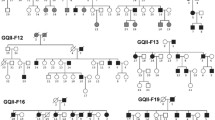Abstract
We identify the SLC22A3-LPAL2-LPA gene cluster as a strong susceptibility locus for coronary artery disease (CAD) through a genome-wide haplotype association (GWHA) study. This locus was not identified from previous genome-wide association (GWA) studies focused on univariate analyses of SNPs. The proposed approach may have wide utility for analyzing GWA data for other complex traits.

Similar content being viewed by others
References
Samani, N.J. et al. N. Engl. J. Med. 357, 443–453 (2007).
The Wellcome Trust Case Control Consortium. Nature 447, 661–678 (2007).
Gagliardi, F. et al. Phil. Transact. A. Math. Phys. Eng. Sci. 363, 1729–1742 (2005).
Fischer, M. et al. Circulation 111, 855–862 (2005).
Wichmann, H.E., Gieger, C. & Illig, T. Gesundheitswesen 67 (Suppl. 1), S26–S30 (2005).
Krawczak, M. et al. Community Genet. 9, 55–66 (2006).
Parra, H.J. et al. Arterioscler. Thromb. 12, 701–707 (1992).
Li, Y. & Abecasis, G.R. Am. J. Hum. Genet. S79, 2290 (2006).
Brazier, L. et al. Atherosclerosis 144, 323–333 (1999).
Holmer, S.R. et al. Circulation 107, 696–701 (2003).
Boerwinkle, E. et al. J. Clin. Invest. 90, 52–60 (1992).
Browning, B.L. & Browning, S.R. Hum. Genet. 123, 273–280 (2008).
Schaefer, E.J. et al. J. Am. Med. Assoc. 271, 999–1003 (1994).
Acknowledgements
The WTCCC Study was funded by the Wellcome Trust. Recruitment of cases for the WTCCC Study was carried out by the British Heart Foundation (BHF) Family Heart Study Research Group and supported by the BHF and the UK Medical Research Council. We also acknowledge support of the Wellcome Trust Functional Genomics Initiative in Cardiovascular Genetics. The German Study was supported by the Deutsche Forschungsgemeinschaft, the German Federal Ministry of Education and Research in the context of the German National Genome Research Network (NGFN-2 and NGFN-plus). The KORA research platform (KORA, Cooperative Research in the Region of Augsburg) was initiated and financed by the GSF-National Research Centre for Environment and Health, which is funded by the German Federal Ministry of Education and Research and of the State of Bavaria. This work has also been partially supported by the EGEE-II project funded by the European Union INFSO-RI-031688. N.J.S. is supported by a Chair funded by the BHF. The main sponsor of the current analysis is the EU funded integrated project 'Cardiogenics' (LSHM-CT-2006-037593).
Author information
Authors and Affiliations
Consortia
Contributions
This work was designed by D.-A.T., L.T., F.C., H.S. and N.J.S. Statistical analyses were carried out by D.-A.T., I.R.K., A.G., M.P., P.H., A.Z. and J.R.T., J.E., P.S.B., C.P., M.D., P.B. and W.O. supervised and/or participated in the genetic laboratory analyses. A.M. developed the computing grid program under the supervision of D.-A.T. and C.G. Case collections were coordinated by P.S.B., A.S.H., B.J.W., A.J.B., S.G.B., W.O., J.R.T., N.J.S. (WTCCC), J.E., T.M., H.-E.W., C. Meisinger, C.H., K.N., K.S., J.S., D.R. (GerMIFS), S.S., A.S., N.E.E.-M. (PopGene), J.E., P.L.-N. (Angio-Luebeck), A.E., D.A., G.L., J.-B.R., and C. Morrison (ECTIM). D.A.T., L.T., F.C., H.S. and N.J.S. drafted the manuscript with substantial contributions from I.R.K., J.E., A.Z.
Corresponding author
Additional information
A full list of members is provided in the Supplementary Note.
A full list of members is provided in the Supplementary Note.
Supplementary information
Supplementary Text and Figures
Supplementary Methods, Supplementary Tables 1–3, Supplementary Figures 1–3 and Supplementary Note (PDF 746 kb)
Rights and permissions
About this article
Cite this article
Trégouët, DA., König, I., Erdmann, J. et al. Genome-wide haplotype association study identifies the SLC22A3-LPAL2-LPA gene cluster as a risk locus for coronary artery disease. Nat Genet 41, 283–285 (2009). https://doi.org/10.1038/ng.314
Received:
Accepted:
Published:
Issue Date:
DOI: https://doi.org/10.1038/ng.314
- Springer Nature America, Inc.
This article is cited by
-
Novel molecular mechanisms of doxorubicin cardiotoxicity: latest leading-edge advances and clinical implications
Molecular and Cellular Biochemistry (2024)
-
Genetic preservation of SLC22A3 in the Admixed and Xhosa populations living in the Western Cape
Molecular Biology Reports (2023)
-
PLEACH: a new heuristic algorithm for pure parsimony haploty** problem
The Journal of Supercomputing (2023)
-
High Throughput Screening of a Prescription Drug Library for Inhibitors of Organic Cation Transporter 3, OCT3
Pharmaceutical Research (2022)
-
Lipoprotein (a): When to Measure and How to Treat?
Current Atherosclerosis Reports (2021)





